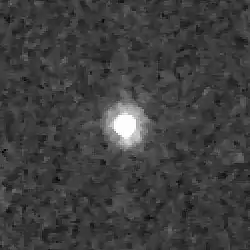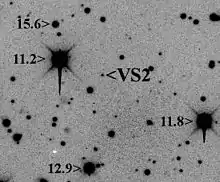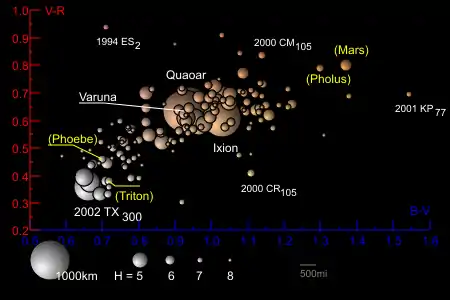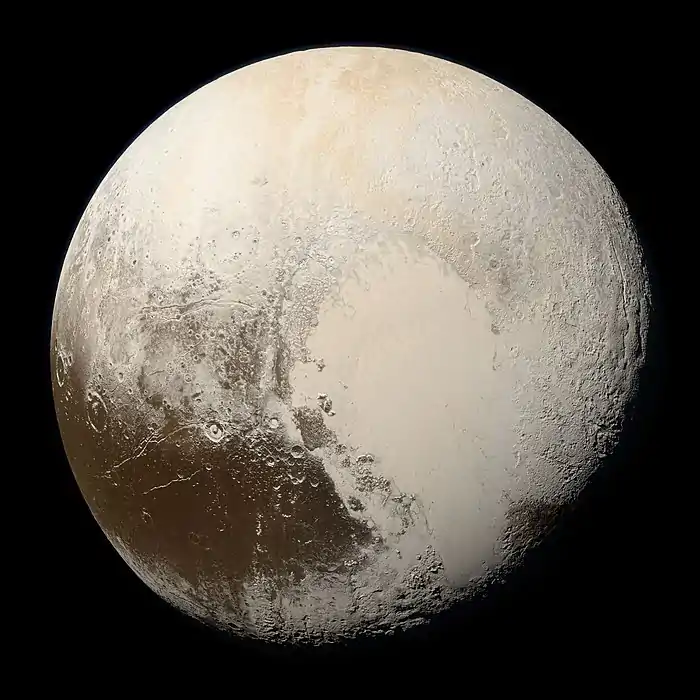(84922) 2003 VS2
(84922) 2003 VS2 is a trans-Neptunian object discovered by the Near Earth Asteroid Tracking program on 14 November 2003.[1] Like Pluto, it is in a 2:3 orbital resonance with Neptune[3][4] and is thus a plutino. Mike Brown's website lists it as "likely" a dwarf planet.[10] However, Brown assumed that 2003 VS2 was significantly larger than it really is, and analysis of its light-curve suggests that it may not be in the hydrostatic equilibrium.[11]
 Hubble Space Telescope image of 2003 VS2 taken in 2005 | |
| Discovery[1] | |
|---|---|
| Discovered by | NEAT (644) |
| Discovery date | 14 November 2003[2] |
| Designations | |
| (84922) 2003 VS2 | |
| none | |
| Plutino[3][4] | |
| Orbital characteristics[2][3] | |
| Epoch 13 January 2016 (JD 2457400.5) | |
| Uncertainty parameter 3 | |
| Observation arc | 8830 days (24.18 yr) |
| Earliest precovery date | 17 September 1991 |
| Aphelion | 42.413 AU (6.3449 Tm) |
| Perihelion | 36.456 AU (5.4537 Tm) |
| 39.435 AU (5.8994 Tm) | |
| Eccentricity | 0.075539 |
| 247.64 yr (90451.3 d) | |
Average orbital speed | 4.75 km/s |
| 15.535° | |
| 0° 0m 14.328s / day | |
| Inclination | 14.777° |
| 302.792° | |
| 114.317° | |
| Physical characteristics | |
| Dimensions | (627.6+14.2 −14.2) × (531+17.6 −19.6) × (494.6+53.2 −87.2) km[5] |
Mean diameter | |
Mean density | 1.4+1.0 −0.3 g/cm3[5] |
| 7.4175285±0.00001 h[7] | |
Sidereal rotation period | 7.41±0.02 h[8] |
| 0.131+0.024 −0.013[5] | |
| Temperature | ≈44 K |
| |
| 19.7[9] | |
Orbit and rotation
Like Pluto, (84922) 2003 VS2 is locked in the 3:2 mean-motion resonance with Neptune, although its orbit is both less inclined and significantly less eccentric than Pluto's.[2]
(84922) 2003 VS2 has a significant light-curve amplitude of 0.21±0.01. The most likely value of the rotation period is 7.41±0.02 h.[8]
Physical characteristics
(84922) 2003 VS2 has a moderately red surface with a moderately red color indices B−V=0.93, V−R=0.59.[12] Its geometrical albedo is about 0.13.[5]
In 2007, its diameter was initially estimated by the Spitzer Space Telescope at 725±200 km.[13] However, in 2012, this was reduced to 523.0+35.1
−34.4 km after new Herschel Space Telescope observations.[6] In 2019, 2003 VS2 was found to be ellipsoidal in shape based on stellar occultations that occurred in 2013 and 2014;[5] the light curve derived from the occultations suggests that this plutino is not in hydrostatic equilibrium and hence not a dwarf planet.[14] The dimensions of 2003 VS2 are estimated at 627.6 km × 531 km × 494.6 km, with a volume-equivalent diameter 548.3+29.5
−44.6 km.[5] 2003 VS2 has no known satellite that can be used to directly determine its mass, but assuming a density of 1 g/cm3, typical of mid size TNO's,[15] gives a mass estimate of about 7.5×1019 kg.

See also
- Sedna, another large trans-Neptunian object discovered the same day (14 November 2003)
References
- Marsden, Brian G. (16 November 2003). "MPEC 2003-W02 : 2003 VS2". IAU Minor Planet Center. Harvard-Smithsonian Center for Astrophysics. Retrieved 6 January 2010.
- "JPL Small-Body Database Browser: 84922 (2003 VS2)" (2008-02-05 last obs). Retrieved 7 April 2016.
- Buie, Marc W. (5 February 2008). "Orbit Fit and Astrometric record for 84922". SwRI (Space Science Department). Retrieved 23 July 2008.
- "MPEC 2006-X45 : Distant Minor Planets". Minor Planet Center & Tamkin Foundation Computer Network. 21 December 2006. Archived from the original on 28 August 2008. Retrieved 23 July 2008.
- Benedetti-Rossi, Gustavo; Santos-Sanz, P.; Ortiz, J. L.; Assafin, M.; Sicardy, B.; Morales, N. (2019). "The trans-Neptunian object (84922) 2003 VS2 through stellar occultations". The Astronomical Journal. 158 (4). arXiv:1908.06645. doi:10.3847/1538-3881/ab3b05.
- Mommert, Michael; Harris, A. W.; Kiss, C.; Pál, A.; Santos-Sanz, P.; Stansberry, J.; Delsanti, A.; Vilenius, E.; Müller, T. G.; Peixinho, N.; Lellouch, E.; Szalai, N.; Henry, F.; Duffard, R.; Fornasier, S.; Hartogh, P.; Mueller, M.; Ortiz, J. L.; Protopapa, S.; Rengel, M.; Thirouin, A. (May 2012). "TNOs are cool: A survey of the trans-Neptunian region—V. Physical characterization of 18 Plutinos using Herschel-PACS observations". Astronomy & Astrophysics. 541: A93. arXiv:1202.3657. Bibcode:2012A&A...541A..93M. doi:10.1051/0004-6361/201118562.
- Santos-Sanz, P.; Lellouch, E.; Groussin, O.; Lacerda, P.; Muller, T.G.; Ortiz, J.L.; Kiss, C.; Vilenius, E.; Stansberry, J.; Duffard, R.; Fornasier, S.; Jorda, L.; Thirouin, A. (August 2017). ""TNOs are Cool": A survey of the trans-Neptunian region XII. Thermal light curves of Haumea, 2003 VS2 and 2003 AZ84 with Herschel/PACS". Astronomy & Astrophysics. 604 (A95): 19. arXiv:1705.09117. Bibcode:2017A&A...604A..95S. doi:10.1051/0004-6361/201630354.
- Sheppard, Scott S. (August 2007). "Light Curves of Dwarf Plutonian Planets and other Large Kuiper Belt Objects: Their Rotations, Phase Functions, and Absolute Magnitudes". The Astronomical Journal. 134 (2): 787–798. arXiv:0704.1636. Bibcode:2007AJ....134..787S. doi:10.1086/519072.
- "AstDys (84922) 2003VS2 Ephemerides". Department of Mathematics, University of Pisa, Italy. Archived from the original on 12 July 2012. Retrieved 7 December 2009.
- Brown, Michael E. "How many dwarf planets are there in the outer solar system? (updates daily)". California Institute of Technology. Retrieved 31 August 2016.
- Tancredi, Gonzalo (2009). "Physical and dynamical characteristics of icy "dwarf planets" (plutoids)". Proceedings of the International Astronomical Union Symposium S263. 5: 173–185. Bibcode:2010IAUS..263..173T. doi:10.1017/S1743921310001717. (Dwarf Planet & Plutoid Headquarters)
- Tegler, Stephen C. (1 February 2007). "Kuiper Belt Object Magnitudes and Surface Colors". Archived from the original on 1 September 2006. Retrieved 30 December 2009.
- Stansberry, John; Grundy, Will; Brown, Mike; Cruikshank, Dale; Spencer, John; Trilling, David; Margot, Jean-Luc (2008). "Physical Properties of Kuiper Belt and Centaur Objects: Constraints from Spitzer Space Telescope" (PDF). In Barucci, M. Antonietta; Boehnhardt, Hermann; Cruikshank, Dale P. (eds.). The Solar System Beyond Neptune. University of Arizona press. pp. 161–179. arXiv:astro-ph/0702538. Bibcode:2008ssbn.book..161S. ISBN 978-0-8165-2755-7.
- Benedetti-Rossi, Gustavo; Santos-Sanz, Pablo; Ortiz, Jose Luis; Assafin, Marcelo; Sicardy, Bruno; Vieira-Martins, Roberto; Braga-Ribas, Felipe (2019). "Three Stellar Occultations by the Plutino Object (84922) 2003 VS2". Epsc-DPS Joint Meeting 2019. 2019: EPSC-DPS2019-435. Bibcode:2019EPSC...13..435B.
- Grundy, W.M.; Noll, K.S.; Buie, M.W.; Benecchi, S.D.; Ragozzine, D.; Roe, H.G. (2019). "The mutual orbit, mass, and density of transneptunian binary Gǃkúnǁ'hòmdímà (229762 2007 UK126)". Icarus. 334: 30–38. Bibcode:2019Icar..334...30G. doi:10.1016/j.icarus.2018.12.037.
External links
- Huge rock-ice body circles Sun (Palomar Photo)
- 2003 VS2 precovery (18 Nov. '03 Major News about Minor Objects)
- (84922) 2003 VS2 at the JPL Small-Body Database

_(cropped).jpg.webp)
